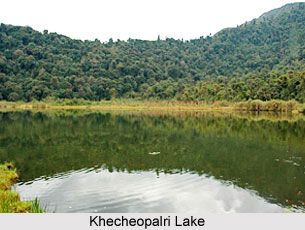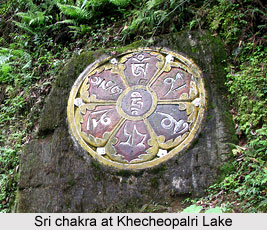 Khecheopalri Lake, also known as Kha-Chot-Palri, is a holy lake located Pelling town of West Sikkim district, of Sikkim. The lake is considered sacred by both Hindus and Buddhists and is assumed to fulfill inner desires. It is thus called the "Wish Fulfilling Lake" as well. Khecheopalri Lake, which literally means, Heaven of Padmasambhava, is situated in the Khecheopalri village, 34 km in the northwest of Pelling and 147 km to the west of Gangtok, in the northeastern state of Sikkim. The lake is locally called Sho Dzo Sho, which means "Oh Lady, Sit Here." Khecheopalri Lake is an essential part of the much respected Demazong valley (valley of rice). The land is believed to be sanctified by Guru Padmasambhava and known as land of hidden treasures. Khecheopalri Lake is amongst the popular Buddhist pilgrimage sites, which also includes Pemayangtse Monastery, Yuksom, Rabdentse ruins, Tashiding Monastery, Dubdi Monastery and Sanga Choeling Monastery.
Khecheopalri Lake, also known as Kha-Chot-Palri, is a holy lake located Pelling town of West Sikkim district, of Sikkim. The lake is considered sacred by both Hindus and Buddhists and is assumed to fulfill inner desires. It is thus called the "Wish Fulfilling Lake" as well. Khecheopalri Lake, which literally means, Heaven of Padmasambhava, is situated in the Khecheopalri village, 34 km in the northwest of Pelling and 147 km to the west of Gangtok, in the northeastern state of Sikkim. The lake is locally called Sho Dzo Sho, which means "Oh Lady, Sit Here." Khecheopalri Lake is an essential part of the much respected Demazong valley (valley of rice). The land is believed to be sanctified by Guru Padmasambhava and known as land of hidden treasures. Khecheopalri Lake is amongst the popular Buddhist pilgrimage sites, which also includes Pemayangtse Monastery, Yuksom, Rabdentse ruins, Tashiding Monastery, Dubdi Monastery and Sanga Choeling Monastery.
An astounding quality of the lake is that the water surface always remains clean and as soon as any leaves fall on the water, resident birds pick them up instantly. The Khecheopalri Lake and the Kanchenjunga National Park are conserved from the biodiversity perspective with ecotourism and pilgrimage as essential off shoots. As a result, their recreational and sacredness values are enhanced.
Etymology of Khecheopalri Lake
As per local myths, the name of the lake is derived from 2 words, Khecheo, meaning Flying Yoginis or Taras (female incarnations of Avalokiteshvara), and Palri, which means Palace.
Legend of Khecheopalri Lake
According to sacred Buddhist scriptures of Sikkim, the formation of Khecheopalri Lake occurred after the invasion of Nepal in mid-17th century. The Nepali army ravaged the royal palace of the Namgyal Dynasty, at Rabdentse and also destroyed a sacred lake at Yuksum in West Sikkim. One day the resident god of the lake appeared in front of a monk and asked him to fetch a vessel of water from the lake. After the monk did what he was asked, the deity guided him to Khecheopalri Hill. Then the monk poured the water in to a shallow area of the lake, while praying. The lake then filled up miraculously.
According to another legend, the area of Khecheopalri Lake was a grazing ground long time ago. The area was covered by nettle. One day, a Lepcha couple saw a few conch shells falling on the ground from the air. Eventually the ground shook frantically and spring water came out from underground and thus Khecheopalri Lake was formed.
Climate of Khecheopalri Lake
The maximum temperature of Khecheopalri Lake is 24 degree Celsius; where as minimum temperature is recorded at 4 degree Celsius. Monsoon prevails almost through out the year in the region.
Topography of Khecheopalri Lake
Khecheopalri Lake is estimated to have been formed around 3500 years ago. The lake is located at an elevation of 1,700 m, nestled in a serene forest, near Tsozo village. It has a drainage area of 12 sq km and drains a catchment area of the Ramam watershed. The border of lake has the shape of a foot and is believed to be a divine imprint of Lord Buddha`s foot. The surface water of the lake is spread across an area of 3.79 hectares and the lake is almost 7.2 m deep in average, although the depth varies from 3.2-11.2 m at different parts. Khecheopalri Lake has only one outlet for outflow and inflow is from 2 perennial streams and 5 non-perennial streams. The area of the lake is covered by a dense forest of temperate vegetation and bamboo.
Flora and Fauna of Khecheopalri Lake
Khecheopalri Lake is located amidst broad-leaved mixed temperate forest. The natural vegetation of the lake itself comprises of various species of Zooplankton, Phytoplankton and Macrophytes. Various types of fishes are also present here, like Danio aequipinnatus, Schziothorax sp, Cyprinus carpio, Schistura sp and Garra sp. Various types of bird species are also found here, like cormorant, grebe, merganser common teal, crane etc. Trans-Himalayan migratory birds take shelter in this area as well.
Religious Significance of Khecheopalri Lake
 Khecheopalri Lake is very much important to the followers of Buddhism as well as Hinduism. Several tourists and pilgrims visit the Placid Lake through out the year. The walk from the entrance gate upto the lake takes almost 15 minutes through the pristine tropical forest. The jetty at the lake leads to the water front, where the scared the rituals are conducted. Along the jetty, several Prayer wheels and flags, with Tibetan inscriptions, are fixed. Annual Buddhist rituals are perfromed at the lake. The water of the lake is utilised only for performing rites and rituals.
Khecheopalri Lake is very much important to the followers of Buddhism as well as Hinduism. Several tourists and pilgrims visit the Placid Lake through out the year. The walk from the entrance gate upto the lake takes almost 15 minutes through the pristine tropical forest. The jetty at the lake leads to the water front, where the scared the rituals are conducted. Along the jetty, several Prayer wheels and flags, with Tibetan inscriptions, are fixed. Annual Buddhist rituals are perfromed at the lake. The water of the lake is utilised only for performing rites and rituals.
An annual religious fair, which is amongst the largest festivals, is conducted here during Maghe Purne, in the months of March-April, for 2 days. Huge numbers of pilgrims attend the fair from all parts of the country, and even from Nepal and Bhutan as well. The pilgrims carry the blessed water of the lake as Prasad. Butter lamps on bamboo boats, tied with Khadas, are floated on Khecheopalri Lake, on bamboo boats tied with Khadas. Prayers are chanted in reverence and food is offered to the Lake god. In October, another festival, Chho-Tsho, is conducted here.
It is believed that Lord Shiva meditated in Dupukney Cave, located above the lake. Thus, Khecheopalri Lake is of much significance to Hindus as well.
Current Situation of Khecheopalri Lake
In the last few years, tourist inflow into Sikkim has increased manifold. Moreover, the residents of the nearby village exploit the natural resources of the lake which effects in loss of biodiversity, which results from deforestation and adoption of harmful land-use practices. Various religious and ritualistic practices by the pilgrims also add to the increase in acidity of the lake waters, as the decomposition of waste material harms the water of the lake.
Conservation of Khecheopalri Lake
In order to improve the biodiversity in the Khecheopalri Lake, ecotourism is now being promoted, along with the support of local communities. Further measures include prohibition of Swimming, fishing, boating or any other recreational activities at the lake. Moreover, other measures are also taken like afforestation of the forest areas; prayers are to be made in the monastery, instead of the lake; discouraging grazing in the catchment areas; and implementation of proper management with involvement local inhabitants. Furthermore, the Khecheopalri Holy Lake Welfare Committee (KHLWC), along with the locals, has taken adequate steps to ensure management and conservation of the lake.
Khecheopalri lake has been declared as a Protected Lake by the Government of Sikkim in the year 2001 (Notification no. 701/Home/2001/dated 20-09-2001).



















